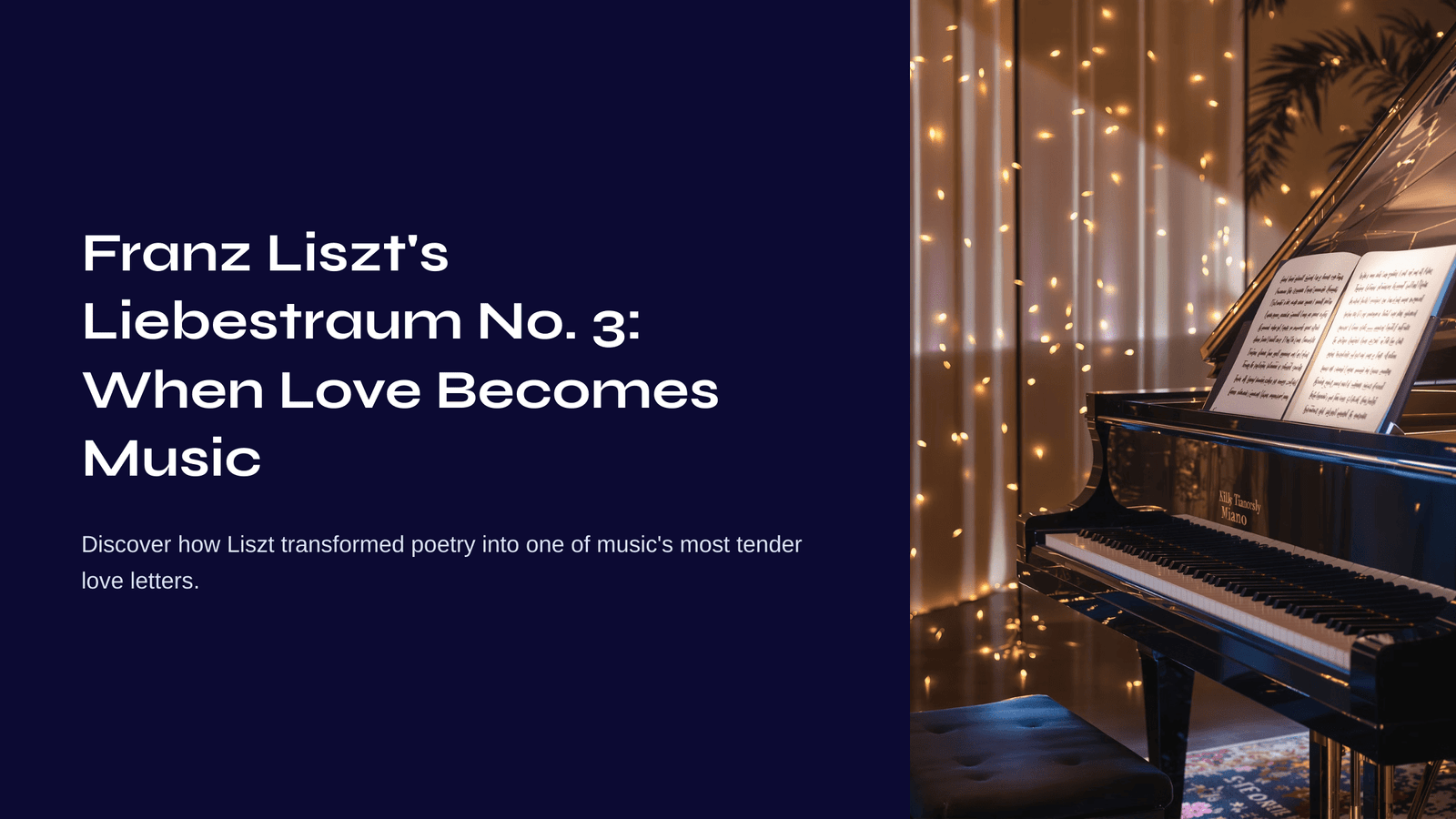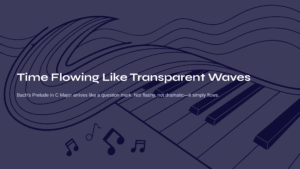Table of Contents

When Poetry Meets Piano Keys
There’s something magical about discovering a piece of music that seems to speak directly to your soul. You know that moment when the first few notes float through the air, and suddenly everything else fades away? That’s exactly what happens when Franz Liszt’s Liebestraum No. 3 begins to unfold. This isn’t just another pretty piano piece – it’s a conversation between love and loss, between dreams and reality, captured in the most tender musical phrases you’ll ever hear.
The German word “Liebestraum” translates to “Dream of Love,” and trust me, Liszt knew exactly what he was doing when he chose that title. This piece doesn’t just play with your emotions; it takes them on a complete journey, from the gentle awakening of love to the passionate heights of devotion, and finally to the bittersweet acceptance of love’s fragility.

A Love Letter Written in Musical Notes
When Liszt composed this masterpiece in 1850, he wasn’t just sitting at the piano experimenting with pretty melodies. He had something much deeper in mind. The piece was originally based on a heart-wrenching poem by Ferdinand Freiligrath called “O lieb, so lang du lieben kannst” – “Oh love, as long as you can love.” If that title doesn’t give you chills, just wait until you hear what Liszt did with it musically.
The poem’s message is both beautiful and devastating: love fully while you can, because death will eventually separate all lovers. It’s the kind of truth that hits you in the quiet moments of life, when you realize how precious and temporary everything really is. Freiligrath painted vivid images of someone standing at a grave, pleading for forgiveness that can never come, while the deceased “sees and hears you not.”
Liszt, being the genius he was, took this profound literary foundation and transformed it into something even more powerful – music that could make you feel these emotions without needing to understand a single word of German poetry. He created both a vocal version with the original text and this piano solo version, proving that sometimes the most profound things can be said without words at all.
This was during the height of the Romantic era, when artists were breaking away from rigid classical structures and diving headfirst into emotional expression. Composers like Liszt were revolutionizing what music could do – it wasn’t just entertainment anymore, it was storytelling, psychology, and philosophy all wrapped up in melody and harmony.

A Musical Journey Through Three Emotional Landscapes
The beauty of Liebestraum No. 3 lies in its perfectly crafted structure, which follows what musicians call a ternary form – think of it as a musical sandwich with three distinct layers that create one cohesive emotional experience.
The Opening Dream The piece begins like a gentle awakening from sleep, with the main melody floating delicately in A-flat major. This isn’t your typical piano showpiece that grabs you by the collar – instead, it whispers sweet nothings in your ear. The melody seems to drift between the pianist’s hands like a conversation between lovers, sometimes tender, sometimes yearning, but always intimate.
What makes this opening so special is how Liszt treats the melody like a human voice. You can almost hear the words of the original poem being sung, even in the instrumental version. The harmonies underneath are rich and warm, filled with those seventh chords that give the music its particularly Romantic flavor – think of them as the musical equivalent of a sunset’s golden glow.
The Passionate Awakening After the first dreamy cadenza – a brief moment where the pianist gets to show off a bit while maintaining the musical flow – we return to the main theme, but now it’s slightly more intense, like love deepening with time. The melody becomes more elaborate, the emotions more complex, preparing us for what’s about to happen.
The Storm of the Heart Then comes the middle section, and this is where Liszt shows his true genius. The music suddenly erupts into a passionate climax that shifts through different keys – C major, E major, back to A-flat – like someone pacing frantically while lost in emotional turmoil. This is where you hear the “pain, hope, and plenty of love” that captures the poem’s central crisis.
The dynamics explode from the gentle opening to fortissimo – as loud and intense as the piano can manage. If the opening was a whispered “I love you,” this middle section is someone crying out “Why must all good things end?” It’s the moment when the dream collides with reality, when the awareness of mortality crashes into the bliss of love.
The Return to Earth The second cadenza serves as a bridge back to reality, like rain clouds dissipating after a storm. The pianist’s hands descend from the highest register all the way down, representing that journey from passionate turmoil back to earthly acceptance. When the opening theme returns for the final time, it’s changed – still beautiful, still tender, but now tinged with the wisdom that comes from understanding love’s precious fragility.

My Personal Journey with This Piece
Every time I listen to Liebestraum No. 3, I’m struck by how it manages to capture something that’s almost impossible to put into words – that mixture of joy and sadness that comes with deep love. It’s the musical equivalent of watching a beautiful sunset while knowing that night is coming.
The piece has this incredible ability to make you feel like you’re eavesdropping on someone’s most private emotional moments. During the quiet opening, it feels like witnessing the gentle contentment of two people completely comfortable in each other’s presence. But when that middle section arrives with all its passionate intensity, you’re suddenly experiencing the full weight of what it means to love someone so much that the thought of losing them becomes almost unbearable.
What moves me most is how the piece resolves. It doesn’t end with dramatic flourishes or grand statements – instead, it returns to that same gentle dream-like quality from the beginning, but now it carries the weight of everything that’s happened. It’s like someone who has loved deeply and lost, but has found peace in the memory of what was beautiful.
There’s something profoundly comforting about this musical journey. It tells us that it’s okay to feel all these complex emotions about love – the joy, the fear, the passion, the acceptance. Liszt understood that love isn’t just one thing; it’s a whole spectrum of human experience, and his music gives us permission to feel all of it.

How to Let This Music Touch Your Soul
If you’re planning to listen to Liebestraum No. 3 – and you absolutely should – here are some ways to make the experience even more meaningful:
Create the Right Atmosphere This isn’t background music for doing chores. Find a quiet moment, maybe in the evening when the light is soft, and give the piece your full attention. Close your eyes if it helps you focus on the musical journey rather than visual distractions.
Listen for the Conversation Pay attention to how the melody moves between the pianist’s hands. It’s like following a dialogue between two voices, sometimes answering each other, sometimes singing in harmony. This back-and-forth creates the illusion of that vocal original, even without words.
Feel the Harmonic Colors Those rich seventh chords I mentioned earlier? They’re what give the piece its particularly warm, romantic sound. You don’t need to understand music theory to appreciate how these harmonies make the music feel different from, say, a Mozart piece. Just let yourself notice how the chords seem to glow from within.
Embrace the Dynamic Journey The piece takes you from whisper-quiet to dramatically loud and back again. Don’t resist this emotional rollercoaster – let yourself be carried along. The quiet moments are just as important as the passionate ones, and the contrast between them is what makes the whole experience so powerful.
Consider Different Interpretations Once you’ve fallen in love with the piece (and you will), try listening to different pianists play it. Some emphasize the dreamy aspects, others dig deeper into the darker psychological elements, and each interpretation can reveal new layers of meaning. It’s like seeing a beloved painting in different lighting – same masterpiece, but with new details revealed each time.

The Eternal Dream of Love
Franz Liszt’s Liebestraum No. 3 endures because it speaks to something universally human – our need to love and be loved, coupled with our awareness that nothing lasts forever. But rather than making this reality depressing, Liszt transforms it into something transcendent. The piece suggests that love, even when it’s temporary, has the power to create moments of perfect beauty that echo beyond time.
The music doesn’t just tell us about love; it lets us experience it in all its complexity. It reminds us that the deepest emotions can’t always be captured in words, but sometimes a melody can say everything we need to know. In our fast-paced world, where genuine emotional expression can feel rare, this piece offers a sanctuary – a place where it’s safe to feel deeply and without apology.
When the final notes fade away, they leave behind something that feels like a gentle blessing: the reminder that love, in all its forms, is worth celebrating. Even when it hurts, even when it ends, even when it lives only in memory – it’s still the most beautiful thing we humans do.
That’s the true magic of Liebestraum No. 3. It doesn’t just play music about love; it creates a space where love itself can live and breathe and touch our hearts, one tender note at a time.

If You Loved This, Listen to This Next
If you were moved by Liszt’s deeply emotional journey through love and loss in Liebestraum No. 3, you might find yourself equally captivated by Erik Satie’s Gymnopédie No. 1 – where similar introspective beauty and tender melancholy create an atmosphere of quiet contemplation that speaks to the soul. While Liszt takes you on a passionate emotional rollercoaster, Satie offers a more meditative path to the same destination: that place where music touches something profound within us. Both pieces share an extraordinary ability to transform simple, beautiful melodies into profound statements about the human experience, proving that sometimes the most moving music is also the most deceptively simple.



